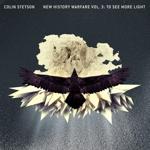
Colin Stetson New History Warfare Vol. 3: To See More Light
(Constellation)
The physical impossibility of the sounds made by hulking bass saxophonist Colin Stetson is generally the first thing you’ll hear about his music. He insists that his albums are performed in single takes – that is, no overdubs, loops, or any other similar trickery – yet there’s such a polyphonic richness to these recordings that it sounds, at times, like five people are present. Particularly amazing is his vein-popping circular breathing technique, which to me still seems as though it should be physically impossible. But it’s not all about what comes out of Stetson’s saxophone: he records from within a web of dozens of microphones capturing sound at every extremity. The magic of how it sounds is not through editing software tricks but the physical harnessing of the sounds he makes – the pummelling of keys, tiny roars from his throat and lungs, glimpses of air escaping from the body of the six-foot-tall instrument.
So this album is engineered rather than produced (with experimental ambient composer Ben Frost playing a key role). There’s a video of Stetson breaking down his song Judges that only goes so far to illuminate just how he creates so many strands of sound at the same time. I’d like to know what it sounds like to stand next to an un-mic’ed Stetson performing these songs; you’d lose entire swathes of sonic depth, but it would emphasise the cleverness of those recording techniques.
But what elevates those techniques beyond mere tricks is how sensitively expressive they can be. Hunted plays around more than ever with positioning and physical movement between microphones, shifting the centre of the sound from the guttural body of the saxophone to the more human tones generated before the breath even hits the sax; it even appears to wander into the next room. It creates this heady, vertiginous rush – adrenaline-inducing in its deftness; and that’s an effect that strikes me as incredibly difficult to recreate in music, afforded only by the uniqueness of Stetson’s approach. It’s like following a camera panning around him, but it leaps and ducks beyond comprehension, digging itself deep in sax pipes.
High Above a Grey Green Sea is, for me, Stetson at his finest – a four-and-a-half minute journey through every way he has of squeezing out sounds, moving from death metal-esque hammering to a ghostly melody that shines out like a crooned soul melisma, the most unbelievable moment on the record in terms of physical recording. The way he seethes through the whole track gives the whole thing a wild and terrifying vitality. That same melody recurs to methodically unifying effect, on the alto sax-led reprise Among the Sef, and is hinted at yet again on closer A Part of You. (Hunted also has its companion piece in the somewhat more contemplative Who The Waves Are Roaring For). But it is with 15-minute centrepiece To See More Light that the indulgence of Stetson’s style is most apparent; this multi-staged journey doesn’t fit in well towards the record’s end. Taken on its own, it is certainly the track in which Stetson covers the most ground, frequently bending both time and pitch as if zooming around corners, and experimenting liberally with harmony and metre.
Stetson breaks up the potential monotony of a solo sax album with four guest appearances by Bon Iver songwriter Justin Vernon. Vernon is impressive in his wide range across his guest spots – from grindcore barking on overblown speedcore epic-in-miniature Brute, to full-on multitracked spine-tingling grandeur on the opener, And In Truth. Resultantly, it feels clear that Stetson is striving for new directions on this third volume of his New History Warfare trilogy, and it’s somewhat messy as a full-length. Its repeated themes and connections spanning the album are admirable in their aspirations to give the record a symphonic gravitas, but don’t give the record the cohesion it needs. This leaves open the intriguing question as to where Stetson might turn next – what accompaniment could possibly complement his already-enormous sound?
I’ve encountered a couple of experimentalist musos who dismiss the “Bon Iver sax guy” and downplay the originality of his approach. (I’ll paraphrase The Wire’s uncharacteristically dismissive review of New History Warfare Vol. 2, condescendingly describing Stetson as “fond of a good tune”). There’s no end to the multitudes of esoteric lowercase music and sax skronkers who might have done something similar to Stetson, but I’ve yet to encounter anyone who uses microphones quite in the same way. I might be wrong, but even if I am, the “originality” question doesn’t matter as much as its execution. The album is stacked with jaw-dropping moments, underpinned by seismic emotional shifts.
29 May, 2013 - 04:18 — Stephen Wragg